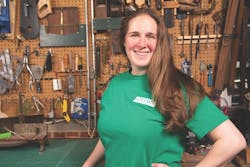3 Ways to Start and Operate a Successful Handyman Division
You’re tired of saying no to clients because a project is too small. You’re considering ways to protect yourself in case the market declines. You want to add value to your business. You’re looking to strengthen your warranty program, or maybe you hope to enhance the client experience. You might want a handyman or a small projects division.
Like with anything in remodeling, though, there are dozens of ways to go about it. The following three remodelers have already found success and experienced the challenges that come with opening, operating, and managing a small projects division in conjunction with design-build remodeling projects.
One decided to keep the division separate from design-build; another opted to keep it connected and solely for past clients; another uses it as a lead generator and offers a monthly handyman subscription.
Although these leaders conduct business differently, all three look at their small projects divisions as an important value-add to their services, and in order to find success, they say it’s vital to remain intentional and hire correctly.
Approach #1: The Client-Exclusive Handyman Division
– Melton Design Build, Boulder, Colo.
– Total Annual Revenue: $23.5 million
– Handyman Revenue: $2 million / 8.5% of total revenue
– Design Build Team: 70
– Handyman Team: One warranty tech executer, one lead carpenter, one office admin
Melton’s first attempt at a handyman division is not the model the business uses today. The first attempt was responding to continued calls for smaller jobs, and the company did its best to meet those needs. At the time, the remodeler had about $12 million in revenue with a goal of $300,000 in sales from small projects and two team members.
But President and Co-owner Graham Steers said two unanticipated negatives came with the cobbled-together approach: those clients only thought of the company as handyman, not design-build. And two: the high stakes.
“When we didn’t do a good job, it left a bad taste in their mouth and their neighbors and the community,” said Steers of that first attempt. “And if you don’t do it well, you might as well not do it at all because it can have a negative impact on your large organization.”
Yet after closing the handyman division, Melton still received many requests for smaller jobs, mainly during warranty check-ins. So Founder Ty Melton hired a consultant for one year to get the division set up correctly.
As an Add-On Selling Point
What resulted was a service that does warranty work and small projects, but only for past clients. Two positives came: Small jobs for existing clients offset the cost of warranty work, and maintaining the relationship made it less likely for a client to go to another remodeler.
“We call it our Client For Life program where we’re taking the warranty team, and warranty process, and using that as a platform to do small projects that we won’t do for people who haven’t done remodels with us,” explains Steers. “So it’s also a selling point.”
The company has 43% repeat and referral design-build work.
The Mini Melton
Steers says the team affectionately calls its Home Care & Repair division the Mini Melton. This is because systems are more lean, as is the team. Basic needs remain, such as the initial phone call, first meeting, an estimate, and contract.
The most impactful part of Mini Melton is its team.
“You need folks that can wear multiple hats and be cross-trained on our processes, and then just be really focused on client satisfaction ... it’s almost like a concierge service,” says Steers. “How can we just create ecstatic clients through these projects that might otherwise not be big money makers? And that the money and the profitability as a business comes after the fact, it’s secondary to the focus on that client satisfaction piece.”
Still, if design-build work ebbs and flows, the team can step in to complete queued small projects.
Just because you can do handyman work doesn’t mean you should.
Align it With Your Vision
Melton’s vision is to create design-build clients for life, so it’s vital to them that their handyman division stays closely tied to its design-build side. And because it can be high stakes for low reward, it’s ideal to limit jobs to past clients.
“Just because you can do handyman work doesn’t mean you should,” says Steers. “I think you have to have a real vision for what it is doing for your organization. And for us, it was clients for life. That was maintaining relationships that we valued. And that’s really where we see success.”
Approach #2: The Subscription-Based Handyman Division
– Schloegel Design Remodel, Kansas City, Mis.
– Total Annual Revenue: $15.3 million
– Handyman Revenue: $4 million / 26% of total revenue
– Design Build Team: 47
– Handyman Team: 13 technicians, one manager/salesperson, one salesperson
CEO Charlie Schloegel made sure Schloegel Design Remodel’s handyman division succeeded because he had no other choice. He wanted to return to the family business, so Schloegel told his father he’d be useful running a handyman division.
“My sole source of income was to sell handyman projects,” he says. “I guess if it didn’t sell anything, I didn’t eat, so I got real intentional about selling handyman.”
This intentionality created consistent year-over-year growth from the division’s launch in January 2012.
A Winning System
The design-build company offers typical handyman services, such as bathroom updates, painting, window replacements, and more.
Handyman projects begin with a consultation and fee of $100 (this acts as a qualifier for clients and is later applied toward the project), followed by a detailed quote, contract, and deposit. This level of front-end work allows the team to operate successfully with a fixed-price model.
To safeguard profitability for the division, Schloegel pared down the design-build process to its bare minimum, with a full-time team of 15, including one manager, one salesperson, and 13 technicians.
Monthly Subscription Model
Schloegel recently relaunched a monthly subscription service for homeowners called the Home Advantage Plan. The first version of the initiative ran for three years. In the old model, clients purchased hours in bulk for the year, with one eight-hour service day in the spring, another in the fall, plus eight hours for any other needs and two hours for an annual inspection.
“It became a lot of negotiation, a lot of individualized needs that we had to meet. And so [the model] wasn’t repeatable,” says Schloegel.
When it became time to revisit the plan, leadership decided to host a focus group of past clients and past service plan subscribers. Two takeaways resulted: Clients wanted the flexibility to call on handyman services as needed and a quicker response time.
To meet these needs, Schloegel Design Remodel now offers a Home Advantage Plan that comes with discount perks between 5% and 10%, no consultation fee, a one-hour minimum rather than the division’s typical two-hour minimum, an annual home assessment, and a guarantee of 72 hours response time or quicker for any job requiring eight hours or less. It runs $75 a month.
“We’re not looking to make money off of the annual subscription,” says Schloegel. “We’re looking to make the money off of the engagement and the retention of the clients.”
We’re looking to make the money off of the engagement and the retention of the clients.
Penetrating a New Market
The goal for Schloegel’s monthly subscription plan is to grow the division by serving more clients with high-quality services.
“The demand is so strong for it. With homeowners aging, they can’t do some things, and then you also have the younger generations who weren’t raised working with their hands that they don’t have any resources,” explains Schloegel.
Schloegel plans to penetrate a market where small jobs may go to less reliable, lower quality businesses by offering the same design-build quality of work, just with smaller scopes and tickets.
“The offering position to our clients is that we’re going to call you back. We’re going to show up,” says Schloegel. “We’re going to meet and I’ll give you a detailed written proposal.”
The goal by the end of 2024 is 200 subscribers. To obtain that number, Schloegel is marketing to past clients through calls, postcard mailers, reaching out to HOAs, purchasing print ads, and SEO optimization. Current subscribers are 70% past clients and 30% new clients.
Approach #3: The Separated Handyman Division
– Merrick Design Build, D.C. Metro
– Total Revenue: $6.6 million
– Handyman Revenue: $600,000 / 9% of revenue
– Design Build Team: Nine carpenters, one production manager
– Handyman Team: Two crew members, one production/sales manager
When Addie Merrick-Phang took the helm as the second-generation owner of Merrick Design Build, one of the major orders of business was to separate the company’s long-standing handyman division and create its own entity, Merrick Home Services.
The division began as a means to retain clients who requested smaller projects. It also served as a way to bring in future design-build business. However, when the two divisions were one, several issues arose: lack of financial oversight, ineffective marketing, and team dedication.
Improved Finances
Merrick-Phang took over in 2019—eight years after the handyman business launched. At that time, the division faced negative net profits. Where the idea had been to use time and materials billing with reconciliation, the team ended up estimating and billing. This caused the largest strain.
While changing the process, Merrick-Phang also set the minimum project as half a day to cover overhead expenses. The team does any job not requiring a permit. Merrick-Phang is looking to increase revenues for Home Services but says, “10% of your overall revenue is a good thing to shoot for.”
Improved Team
A handyman division can either be a dedicated part of the business with intention behind it, or it can be filler work for a design-build company’s crew. Dedication is necessary to find success in a handyman division, says Merrick-Phang.
“It’s one of the biggest opportunities for customer service, building repeat and referral business and funneling [clients] to your main company,” she says. “And it should be treated that way. You should have your friendliest, most approachable people in handyman that are ready to get the dog that just ran out of the door or take the extra step to vacuum their way out of the house.”
Improved Marketing Efforts
When executing the split, Merrick-Phang purposely delivered the news publically to gain traction. She also personally emailed past clients to leave Google reviews, knowing that this newly separated entity needed a foundation for future jobs and SEO. The two companies interact with one another on social media often, too.
“Now handyman has its own website, it has its own social media accounts,” says Merrick-Phang. “And the idea was it needed different Google ads, it needed different keyword searches to get the new business for it. It was lost on our main website. So it just serves better marketing-wise on its own.”
You should have your friendliest, most approachable people in handyman.




